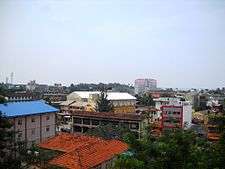Galle District
| Galle District | |
|---|---|
| Administrative District | |
 Map of Sri Lanka with Galle District highlighted | |
| Country | Sri Lanka |
| Province | Southern Province |
| Largest City | Galle |
| Divisions |
List
|
| Government | |
| • District Secretary | Ravindra Hewawitharana |
| • Local |
List
|
| Area | |
| • Total | 1,652 km2 (638 sq mi) |
| • Land | 1,617 km2 (624 sq mi) |
| • Water | 35 km2 (14 sq mi) |
| Population (2001) | |
| • Total | 1,075,000 |
| • Density | 650/km2 (1,700/sq mi) |
| Time zone | Sri Lanka (UTC+05:30) |
| ISO 3166 code | LK-31 |
| Website | galle.dist.gov.lk/ |
Galle (Sinhalese: ගාල්ල දිස්ත්රික්කය gālla distrikkaya; Tamil: காலி மாவட்டம் Kāli māvattam) is a district in Southern Province, Sri Lanka. It is one of 25 districts of Sri Lanka, the second level administrative division of the country. The district is administered by a District Secretariat headed by a District Secretary (previously known as a Government Agent) appointed by the central government of Sri Lanka.
Geological background
Its area is 1,652 km2 (638 sq mi): 35 km2 (14 sq mi) is water and 1,617 km2 (624 sq mi) is land. Galle District bounded on the north by Benthara river, south and west by the Indian Ocean and east by Matara and Ratnapura districts. The topography of Galle District is very much dissent. The climatic condition of Hiniduma Patthuwa is very similar to the central hill country of Sri Lanka. This area consists of rainforests, which is the water catchment area for most of the rivers and lakes flows across Galle District. Sinharaja Forest Reserve is one of them. Galle district lies in a temperate climatic zone.
Annual rainfall is between 2000–2500mm. The river Gin River ("Gin Ganga") starts from Gongala Hill of Hiniduma Patthuwa and in its long journey of 113 km (70 mi). It passes Neluwa, Thawalama, Nagoda Baddegama and Thelikada areas. The river nourishes the land in extent of 922 km2 (356 sq mi). It flows to the Indian Ocean in Ginthota area of Galle District. The river Madu Ganga starts from Polathu Kanda and flows to the sea from Balapitiya and helps to maintain ecological balance in the Galle district.
Historical background
In the ancient Sri Lanka, Galle District secured an important place in the battles against enemies as the capital city of Southern Province. Ancient legends reveal that in 1072 A.C. king Vijayabahu I started his battle against "Soli" in Thambalagamuwa of Hinidum Pattu. According to legends, during the reign of king Dambhadeniya Parakramabahu carried out his battle agents Queen Sugala in the Galle District. Galle was a very important area during the reign of King Maha Parakramabahu and it very much helped the Dutch, Portuguese and English establish their kingdoms.
Galle was called "Gimhathitha." The Sinhalese pronunciation "Gaala" derived from the word "gala" (stone). Gala implies meeting place of bullock carts. Later it was pronounced as "Gaala" as there were large rock and hills in the district.
Cultural background
The sons of the Galle district made immense service to Sinhala literature. Thotagamuwa Vijayaba pirivena, which was a famous educational institute in Kotte era,[1] produced great scholars to the country. Hikkaduwe Sri Sumangala Thera, Migettuwatte Gunananda Thera, Martin Wickramasinghe, P. D. S. Kularathna, Piyasena Kahandagamage, D. J. Wimalasurendra, Senarath Paranavithana, A. T. Ariyaratne and Ariyapala Gurunnanse are some of the sons of Galle district, who did a great service to the motherland.
The Galle Literary festival brings 3,000 people to Galle each January, attracting writers from throughout South Asia.[2]
Major Cities

Suburb of Galle
Urban Councils
Main Towns
- Ahangama
- Ahungalla
- Baddegama
- Balapitiya
- Batapola
- Bentota
- Elpitiya
- Habaraduwa
- Hiniduma
- Imaduwa
- Karandeniya
- Koggala
- Kosgoda
- Mapalagama
- Nagoda
- Neluwa
- Pitigala
- Rathgama
- Thawalama
- Udugama
- Uragasmanhandiya
- Wanduramba
- Yakkalamulla
World Heritage Sites
Forest reserves
- Hiyare Forest Reserve
- Kanneliya Forest Reserve
Maps
References
- ↑ Rulers of Sri Lanka
- ↑ "Literary Festival". Daily Mail. London. 16 October 2011.